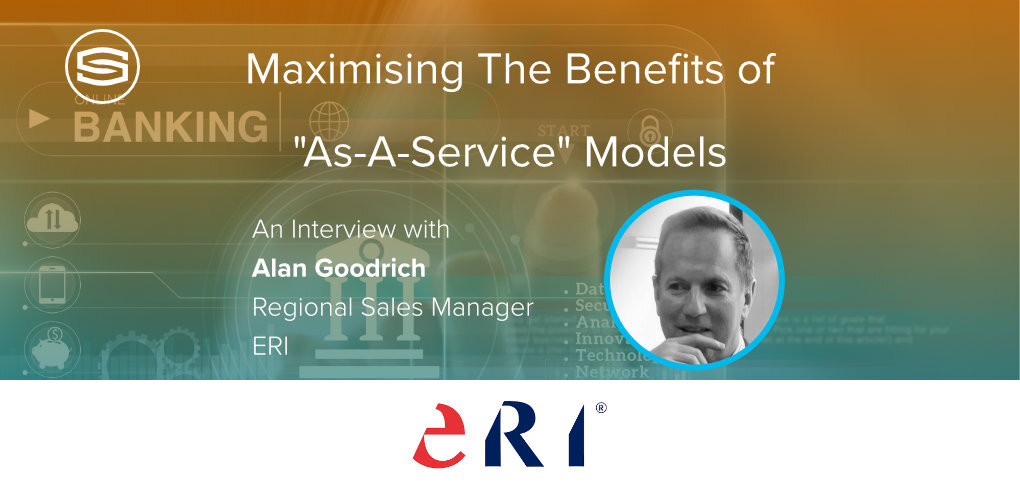
Insights & Opinions
Maximising The Benefits of "As-A-Service" Models
Mon, 09 Oct 2023


You can get almost anything "as-a-Service" these days, including "Tyres-as-a-Service", "Thrust-as-a-Service" and a while ago I even read about "Socks-as-a-Service"! Here at The Banking Scene we are more interested in the agility, flexibility, planning and cost management benefits that the different as-a-Service models can provide to banks, but (just like socks) there really is no "one-size-fits-all" solution that applies to everyone.
In this week's interview with Alan Goodrich, Regional Sales Manager of ERI and, as a loyal member also a frequent attendee at our events, we discover how banks can select the best possible scenario for their situation as we explore "Maximising The Benefits of 'As-A-Service' Models".
Hello, Alan. Please tell us who ERI is and its contribution to the banking and financial services industry.
ERI is an international company specialising in the design, development, distribution and support of the integrated, real-time banking and wealth management software package: OLYMPIC Banking System. Operating in many of the major financial centres, ERI is present in Luxembourg, Geneva, Zurich, Lugano, London, Singapore and Paris.
We focus on providing comprehensive, quality software with effective system implementation assistance and efficient ongoing maintenance and support for clients worldwide. Over 400 banks and financial institutions across 60 countries in Europe, the Middle East, Africa, the Americas, and Asia have chosen OLYMPIC Banking System.
Our mission is to support the growth of our clients' businesses while enabling them to monitor and control their operating costs and expenses in a world of ever-increasing regulatory compliance requirements and digital innovation. Thanks to our product, OLYMPIC Banking System, and our teams of experts we become their long-term partner of choice, responding with agility to their specific needs and challenges.
OLYMPIC Banking System has evolved with the industry, resulting today in a technology-agnostic platform, with all business functionality having being converted into services that allow maximum flexibility for digital delivery, while respecting the risk and security concerns of our clients.
In short, ERI and the OLYMPIC Banking System enable financial services providers to benefit from software that has seen tremendous levels of investment over the years – something that no individual institution could ever achieve on its own.
These days we hear a lot about Infrastructure-as-a-Service, Software-as-a-Service, all the way through to Banking-as-a-Service. Unfortunately, there is no one-size-fits-all solution for every institution, is there? What are the most common models you see for banks today, and why?
There may be no one-size-fits-all solution, and we do currently see a number of different models being implemented. The market is still maturing and some early adopters and suppliers have initially found it hard to achieve the expected or desired outcomes that the as-a-Service transition intended.
As a result, the market seems to be now taking a more cautious incremental approach, sometimes starting with an initial migration to a partial model, such as Infrastructure-as-a-Service, and then, based on lessons learned, adding additional elements moving forward. This may reduce the risks, but may take longer to reap the benefits of the eventual target state.
Some institutions seek to deploy systems using a local hosting partner, while others opt for a public cloud provider, in order to leverage the elasticity and cost flexibility of using shared infrastructure and resources. When it comes to managing the applications, there is a more complex equation to resolve for institutions with existing resources and capacity in order to reduce the potential disruption caused by change.
Going back to the one-size-fits-all question, the as-a-Service models are generally intended to enable the outsourcing of commoditised operational areas and better manage costs and increase resilience. If each institution were to adopt a unique as-a-Service model, then economies of scale are impossible to achieve. Therefore, as with clothes, rather than a one-size-fits-all approach, a well defined set of sizes (XS, S, M, L, XL as-a-Service models) that each fit many would serve the market better.
ERI is able to offer its prospects and clients just such a range of well defined as-a-Service models for the OLYMPIC Banking System, either directly or, depending upon the jurisdiction, in close collaboration with partners.
It's a balancing act between finding the opportunities of flexibility on the one hand and making sure that you can work in a trusted environment on the other. How can these banks select the best possible scenario for their situation?
As discussed before, some of the early adopters of as-a-Service models encountered challenges that the rest of the market is now able to learn from. During the evaluation of scenarios, each institution invariably goes through a process of unbundling their applications and business processes to understand the impact on their operations, including:
- Potential cost savings
- Process Quality
- Controls
- Flexibility
- Security
The result is a much clearer vision of how the as-a-Service model can deliver the expected business benefits as quickly as possible, considering also that such a transformation is not only about technology.
As a supplier, we demonstrate that whichever as-a-Service model the institution wishes to adopt, we have a reliable, trusted offering to support them. We have experience and expertise in a broad range of deployment scenarios; everything from a very traditional on-premise implementation all the way through to delivery of a complete Software-as-a-Service solution. For example, Milleis Banque Privée (formerly Barclays France) mandated ERI Sourcing to manage not only the OLYMPIC Banking System as the backbone, but also the satellite systems that together form the complete ecosystem and solution to manage its business.
Does this mean the exercise is much more than a pure IT dilemma? Should, for example, even HR be involved in this kind of strategic questions?
Absolutely. A technology digital transformation goes hand in hand with an intellectual and cultural digital transformation as well.
Milleis Banque Privée is a good example. Over a hundred bank employees were involved in making the project and transformation a success. Data is now exchanged and client feedback is received in real time, giving every member of staff a single and unified view of the bank’s operations. The transformation also enabled a business restructuring that included reorientation to facilitate digital channels in favour of branches to promote human interactions between Private Bankers and their Clients. So, clearly, there was a very human aspect to the project.
In retaining the brand identity and building unique products and services, banks will need to clearly understand which business or technology aspects could leverage a one-size-fits-all and which ones better not, would you agree?
As mentioned earlier, a well defined set of as-a-Service models, where each model fits many, probably serves the market better than a one-size-fits-all approach.
Differentiating from the competition through; the provision of superior products, services or customer experience, mitigating risks or enabling greater agility to adapt quickly to market opportunities or regulatory changes. These are the aspects that contribute most to brand identity. A key aspect of the unbundling process, as we also discussed, is identifying which are the services that should be retained in-house and which to outsource. To the outside world, whichever as-a-Service model has been adopted to support the business and strengthen the brand identity should be invisible, if successfully implemented.
A final question: How do you see this evolving in the coming years?
The "crystal ball" question. Evolution and change are inevitable in the financial services sector and the pace seems increasingly rapid. It has taken a decade, or perhaps more, for AI to come of age. Now that it has, it may be better to ask ChatGPT the same question?
Faster payments, faster settlement, faster everything is really all about technology. We anticipate that more and more institutions will look to as-a-Service models in order to reduce technology costs and to outsource business processes that bring little, or no, added-value. Probably, this will apply also to the use of AI versus human resources. Ultimately, for banks and financial services providers to remain relevant, they need to focus on being the trusted adviser of customers and safe custodians of their assets, while facilitating transaction processing through a few highly-automated low-cost digital channels.
Whichever as-a-Service model is chosen, the benefits of the OLYMPIC Banking System can already be leveraged by our clients, whether outsourced or kept in-house. ERI is committed to taking the journey with its clients and the markets we serve, wherever it may lead. This means ERI and OLYMPIC Banking System will continually evolve to provide innovative functionality combined with the flexibility to adapt with agility, as well as embracing the next generation of technology and deployment models, whatever they may be.



